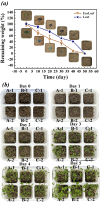Artificial cellulosic leaf with adjustable enzymatic CO2 sequestration capability
- PMID: 38851785
- PMCID: PMC11162438
- DOI: 10.1038/s41467-024-49320-y
Artificial cellulosic leaf with adjustable enzymatic CO2 sequestration capability
Abstract
Developing artificial leaves to address the environmental burden of CO2 is pivotal for advancing our Net Zero Future. In this study, we introduce EcoLeaf, an artificial leaf that closely mimics the characteristics of natural leaves. It harnesses visible light as its sole energy source and orchestrates the controlled expansion and contraction of stomata and the exchange of petiole materials to govern the rate of CO2 sequestration from the atmosphere. Furthermore, EcoLeaf has a cellulose composition and mechanical strength similar to those of natural leaves, allowing it to seamlessly integrate into the ecosystem during use and participate in natural degradation and nutrient cycling processes at the end of its life. We propose that the carbon sequestration pathway within EcoLeaf is adaptable and can serve as a versatile biomimetic platform for diverse biogenic carbon sequestration pathways in the future.
© 2024. The Author(s).
Conflict of interest statement
The authors declare no competing interests.
Figures






Similar articles
-
Guard cell photosynthesis is critical for stomatal turgor production, yet does not directly mediate CO2 - and ABA-induced stomatal closing.Plant J. 2015 Aug;83(4):567-81. doi: 10.1111/tpj.12916. Epub 2015 Jul 22. Plant J. 2015. PMID: 26096271 Free PMC article.
-
Simultaneous and Independent Abaxial and Adaxial Gas Exchange Measurements.Methods Mol Biol. 2024;2790:63-76. doi: 10.1007/978-1-0716-3790-6_4. Methods Mol Biol. 2024. PMID: 38649566
-
Fluorometric Measurement of Individual Stomata Activity and Transpiration via a "Brush-on", Water-Responsive Polymer.Sci Rep. 2016 Aug 31;6:32394. doi: 10.1038/srep32394. Sci Rep. 2016. PMID: 27578430 Free PMC article.
-
Leaf day respiration: low CO2 flux but high significance for metabolism and carbon balance.New Phytol. 2017 Dec;216(4):986-1001. doi: 10.1111/nph.14816. Epub 2017 Oct 2. New Phytol. 2017. PMID: 28967668 Review.
-
Relationships of Leaf Net Photosynthesis, Stomatal Conductance, and Mesophyll Conductance to Primary Metabolism: A Multispecies Meta-Analysis Approach.Plant Physiol. 2016 May;171(1):265-79. doi: 10.1104/pp.15.01660. Epub 2016 Mar 14. Plant Physiol. 2016. PMID: 26977088 Free PMC article. Review.
References
-
- Wang, Z., Hu, Y., Zhang, S., Sun, Y. Artificial photosynthesis systems for solar energy conversion and storage: platforms and their realities. Chem. Soc. Rev. 51, 6704–6737 (2022). - PubMed
-
- Qiu B, et al. Integration of redox cocatalysts for artificial photosynthesis. Energ. Environ. Sci. 2021;14:5260–5288. doi: 10.1039/D1EE02359D. - DOI
MeSH terms
Substances
Grants and funding
LinkOut - more resources
Full Text Sources

